Superabsorbents and Their Application for Heavy Metal Ion Removal in the Presence of EDDS
Abstract
:1. Introduction
2. Materials and Methods
2.1. Materials
2.2. Adsorption Experiments
2.3. Instruments
3. Results and Discussion
3.1. Kinetic Studies
3.2. Equilibrium Adsorption Studies
3.3. Desorption Studies
3.4. THA, ZH and AH Characterization
4. Conclusions
Author Contributions
Funding
Institutional Review Board Statement
Informed Consent Statement
Data Availability Statement
Conflicts of Interest
References
- Ahmed, E.M. Hydrogel: Preparation, characterization and applications: A rewiev. J. Adv. Res. 2015, 6, 105–121. [Google Scholar] [CrossRef] [Green Version]
- Sempeho, S.I.; Kim, H.T.; Mubofu, E.; Hilonga, A. Meticulous overview on the controlled release fertilizers. Adv. Chem. 2014, 2014, 363071. [Google Scholar] [CrossRef]
- Zhan, F.; Liu, M.; Guo, M.; Wu, L. Preparation of superabsorbent polymer with slow-release phosphate fertilizer. J. Appl. Polym. Sci. 2004, 92, 3417–3421. [Google Scholar] [CrossRef]
- Zhong, K.; Lin, Z.T.; Zheng, X.L.; Jiang, G.B.; Fang, Y.S.; Mao, X.Y.; Liao, Z.W. Starch derivative-based superabsorbent with integration of water-retaining and controlled-release fertilizers. Carbohydr. Polym. 2013, 92, 1367–1376. [Google Scholar] [CrossRef]
- Han, X.; Chen, S.; Hub, X. Controlled-release fertilizer encapsulated by starch/polyvinyl alcohol coating. Desalination 2009, 24, 21–26. [Google Scholar] [CrossRef]
- Ni, B.; Liu, M.; Lu, S. Multifunctional slow-release urea fertilizer from ethylcellulose and superabsorbent coated formulations. Chem. Eng. J. 2009, 155, 892–898. [Google Scholar] [CrossRef]
- Bouranis, D.L.; Theodoropoulos, A.G.; Drossopoulos, J.B. Designing synthetic polymers as soil conditioners. Commun. Soil Sci. Plant. Anal. 1995, 26, 1455–1480. [Google Scholar] [CrossRef]
- Wu, L.; Liu, M.Z.; Liang, R. Preparation and properties of a double-coated slow release NPK compound fertilizer with superabsorbent and water-retention. Bioresour. Technol. 2008, 99, 547–554. [Google Scholar] [CrossRef]
- Liu, M.Z.; Liang, R.; Zhan, F.L.; Liu, Z.; Niu, A.Z. Preparation of superabsorbent slow release nitrogen fertilizer by inverse suspension polymerization. Polym. Int. 2007, 56, 729–737. [Google Scholar] [CrossRef]
- Wang, Y.; Liu, M.; Ni, B.; Xie, L.; Zhang, X. Preparation and properties of novel slow-release PK agrochemical formulations based on carboxymethylcellulose-graft-poly(acrylic acid-co-itaconic acid) superabsorbents. J. Macromol. Sci. Part A Pure Appl. Chem. 2007, 48, 806–815. [Google Scholar] [CrossRef]
- Raafat, A.; Eid, M.; El-Arnaouty, M.B. Radiation synthesis of superabsorbent CMC based hydrogels for agriculture applications. Nucl. Instrum. Methods Phys. Res. Sect. B 2012, 283, 71–76. [Google Scholar] [CrossRef]
- Li, A.; Wang, A. Synthesis and properties of clay-based superabsorbent composite. Eur. Polym. J. 2005, 41, 1630–1637. [Google Scholar] [CrossRef]
- Wang, X.; Lu, S.; Gao, C.; Xu, X.; Zhang, X.; Bai, X.; Liu, M.; Wu, L. Highly efficient adsorption of ammonium onto palygorskite nanocomposite and evaluation of its recovery as a multifunctional slow-release fertilizer. Chem. Eng. J. 2014, 252, 404–414. [Google Scholar] [CrossRef]
- Santos, B.R.D.; Bacalhau, F.B.; Tamires, D.S.P.; Souza, C.F.; Faez, R. Chitosan-montmorillonite microspheres: A sustainable fertilizer delivery system. Carbohydr. Polym. 2015, 127, 340–346. [Google Scholar] [CrossRef] [PubMed]
- Kołodyńska, D. The chelating agents of a new generation as an alternative to conventional chelators for heavy metal ions removal from different waste waters. In Expanding Issues in Desalination; Ning, R.Y., Ed.; InTech Publishers: Rijeka, Croatia, 2011; pp. 339–371. ISBN 978-953-307-326-2. [Google Scholar] [CrossRef] [Green Version]
- Sun, X.F.; Liu, B.; Jing, Z.; Wang, H. Preparation and adsorption property of xylan/poly(acrylic acid)magnetic nanocomposite hydrogel adsorbent. Carbohydr. Polym. 2015, 118, 16–23. [Google Scholar] [CrossRef] [PubMed]
- Paulinoa, A.T.; Belfiore, L.A.; Kubota, L.T.; Muniz, E.C.; Tambourgi, E.B. Efficiency of hydrogels based on natural polysaccharides in the removal of Cd(II) ions from aqueous solutions. Chem. Eng. J. 2011, 168, 68–76. [Google Scholar] [CrossRef]
- Milosavljević, N.B.; Ristić, M.D.; Perić-Grujić, A.A.; Filipović, J.M.; Štrbac, S.B.; Rakočević, Z.L.; Kalagasidis Krušić, M.T. Sorption of zinc by novel pH-sensitive hydrogels based on chitosan, itaconic acid and methacrylic acid. J. Hazard. Mater. 2011, 192, 846–854. [Google Scholar] [CrossRef]
- Langmuir, I. The constitution and fundamental properties of solids and liquids. J. Am. Chem. Soc. 1916, 38, 2221–2295. [Google Scholar] [CrossRef] [Green Version]
- Freundlich, H.F.M. About the adsorption in solution. Z. Phys. Chem. 1906, 57, 385–471. [Google Scholar]
- Lagergren, S. Zur theorie der sogenannten adsorption gelosterstoffe. Kungl. Sven. Vetensk. Handl. 1898, 24, 1–39. [Google Scholar]
- Ho, Y.S.; McKay, G. Sorption of dye from aqueous solution by peat. Chem. Eng. J. 1998, 70, 115–124. [Google Scholar] [CrossRef]
- Weber, W.J.; Morris, J.C. Kinetics of adsorption on carbon from solution. J. Sanit. Eng. Div. 1963, 89, 31–60. [Google Scholar] [CrossRef]
- Yildiz, U.; Kemik, Ö.F.; Hazer, B. The removal of heavy metal ions from aqueous solutions by novel pH-sensitive hydrogels. J. Hazard. Mater. 2010, 183, 521–532. [Google Scholar] [CrossRef] [PubMed]
- Sharaf, M.A.; Arida, H.A.; Sayed, S.A.; Younis, A.A.; Farag, A.B. Separation and preconcentration of some heavy-metal ions using new chelating polymeric hydrogels. J. Appl. Polym. Sci. 2009, 113, 1335–1344. [Google Scholar] [CrossRef]
- Saeed, A.M.; Shadahan, G.; Khatham, S.H. Zinc(II) ion removal from aqueous solution using commercial hydrogel beads and AAS measurements. Int. J. Appl. Innov. Eng. Manag. 2015, 4, 31–38. [Google Scholar]
- Peng, X.W.; Zhong, L.X.; Ren, J.L.; Sun, R.C. Highly effective adsorption of heavy metal ions from aqueous solutions by macroporous xylan-rich hemicelluloses-based hydrogel. J. Agric. Food Chem. 2012, 60, 3909–3916. [Google Scholar] [CrossRef]
- Kołodyńska, D.; Skiba, A.; Górecka, B.; Hubicki, Z. Hydrogels—from fundaments to application. In Hydrogels; Majee, S.B., Ed.; InTech Publishers: Rijeka, Croatia, 2016; pp. 60–100. ISBN 980-953-307-139-3. [Google Scholar] [CrossRef] [Green Version]
- Szabó, T.; Domokos, G. A new classification system for pebble and crystal shapes based on static equilibrium points. Cent. Eur. Geol. 2010, 53, 1–19. [Google Scholar] [CrossRef] [Green Version]
- Li, X.; Li, Q.; Su, Y.; Yue, Q.; Gao, B.; Su, Y. A novel wheat straw cellulose-based semi-IPNs superabsorbent with integration of water-retaining and controlled-release fertilizers. J. Taiwan Inst. Chem. Eng. 2015, 55, 170–179. [Google Scholar] [CrossRef]
- Pal, P.; Pandey, J.P.; Sen, G. Modified PVP based hydrogel: Synthesis, characterization and application in selective abstraction of metal ions from water. Mater. Chem. Phys. 2017, 194, 261–273. [Google Scholar] [CrossRef]
- Fosso-Kankeu, E.; Mittal, H.; Waanders, F.; Ray, S.S. Thermodynamic properties and adsorption behaviour of hydrogel nanocomposites for cadmium, removal from mine effluents. J. Ind. Eng. Chem. 2017, 48, 151–161. [Google Scholar] [CrossRef]
- Orozco-Guareńo, E.; Santiago-Gutiérrez, F.; Morán-Quiroz, J.L.; Hernandez-Olmos, S.L.; Soto, V.; De la Cruz, W.; Manríquez, R.; Gomez-Salazar, S. Removal of Cu(II) ions from aqueous streams using poly(acrylic acid-co-acrylamide) hydrogels. J. Colloid Interface Sci. 2010, 349, 583–593. [Google Scholar] [CrossRef] [PubMed]
- Bialik-Wąs, K.; Tyliszczak, B.; Wilk, E.; Pielichowski, K. Otrzymywanie innowacyjnych opatrunków hydrożelowych w oparciu o poli(kwas akrylowy). Chemik 2013, 67, 11–13. [Google Scholar]

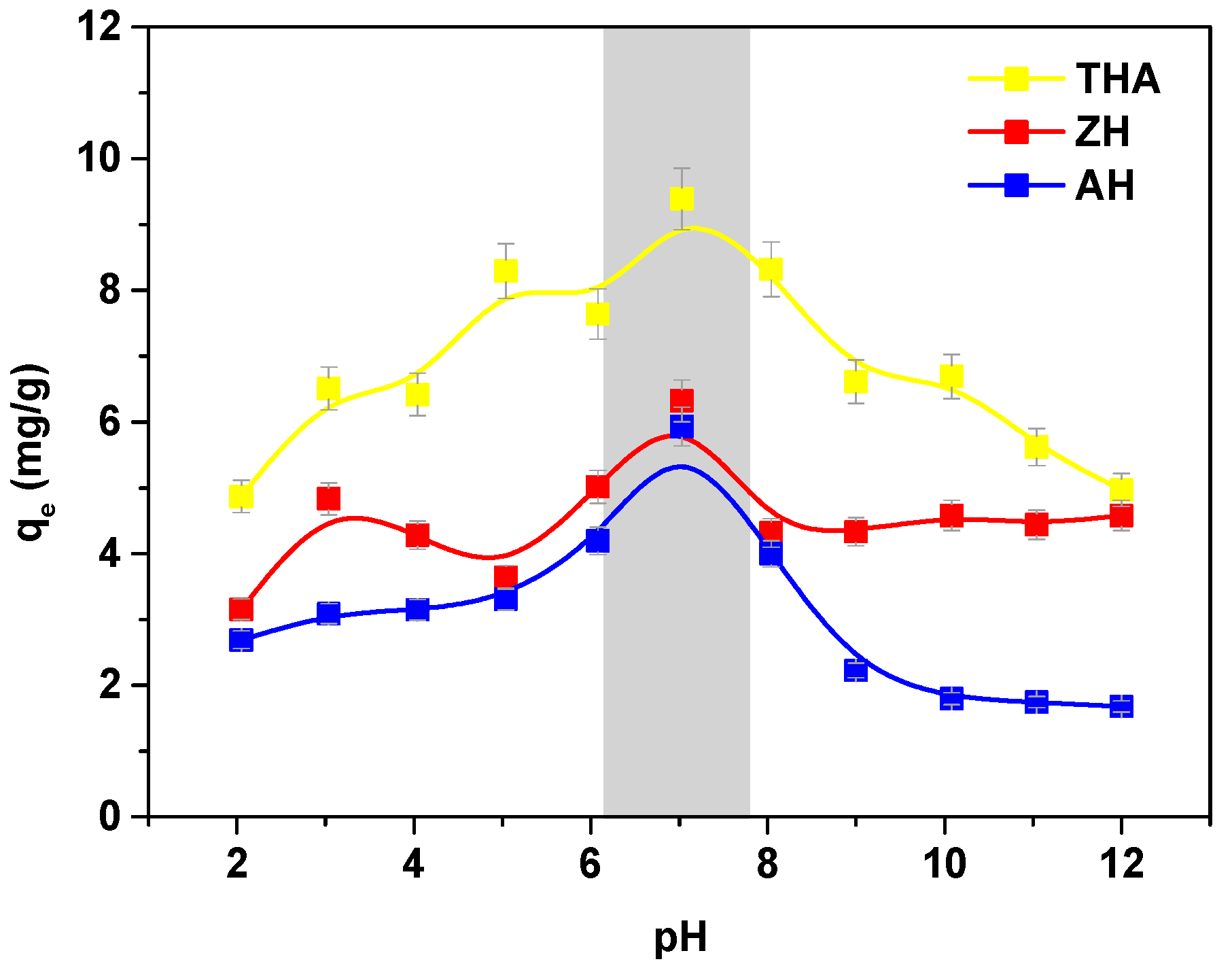
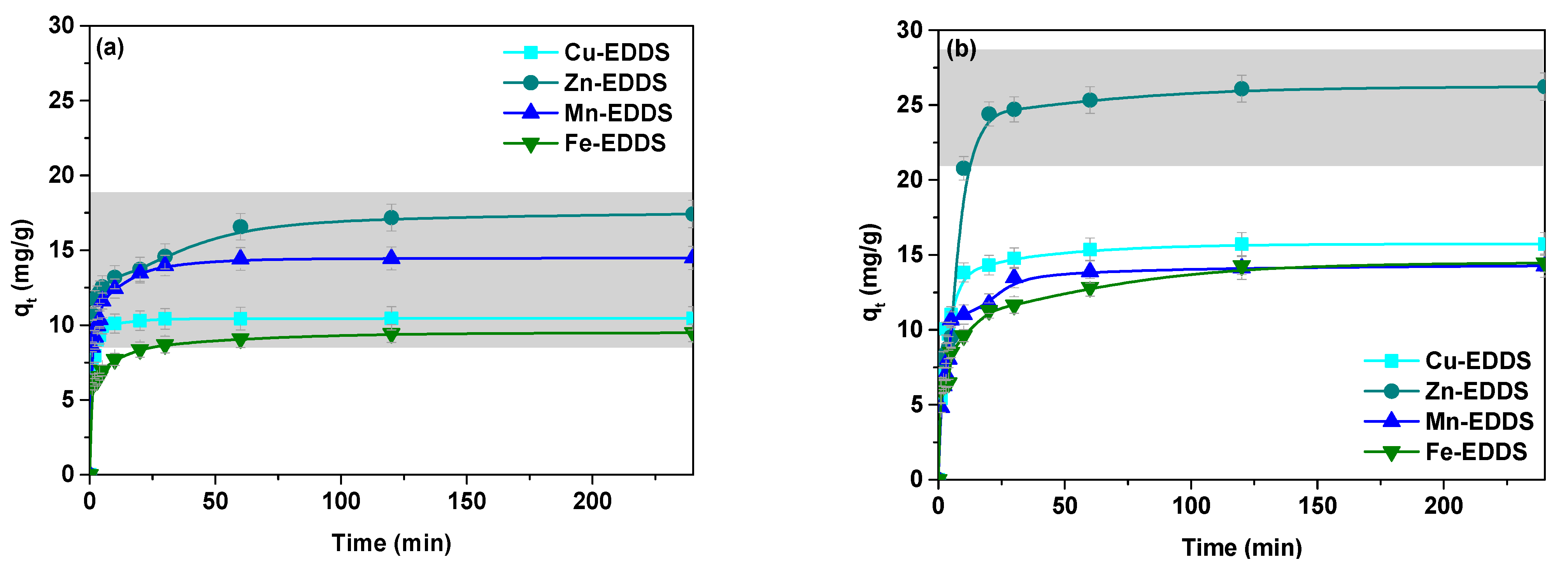

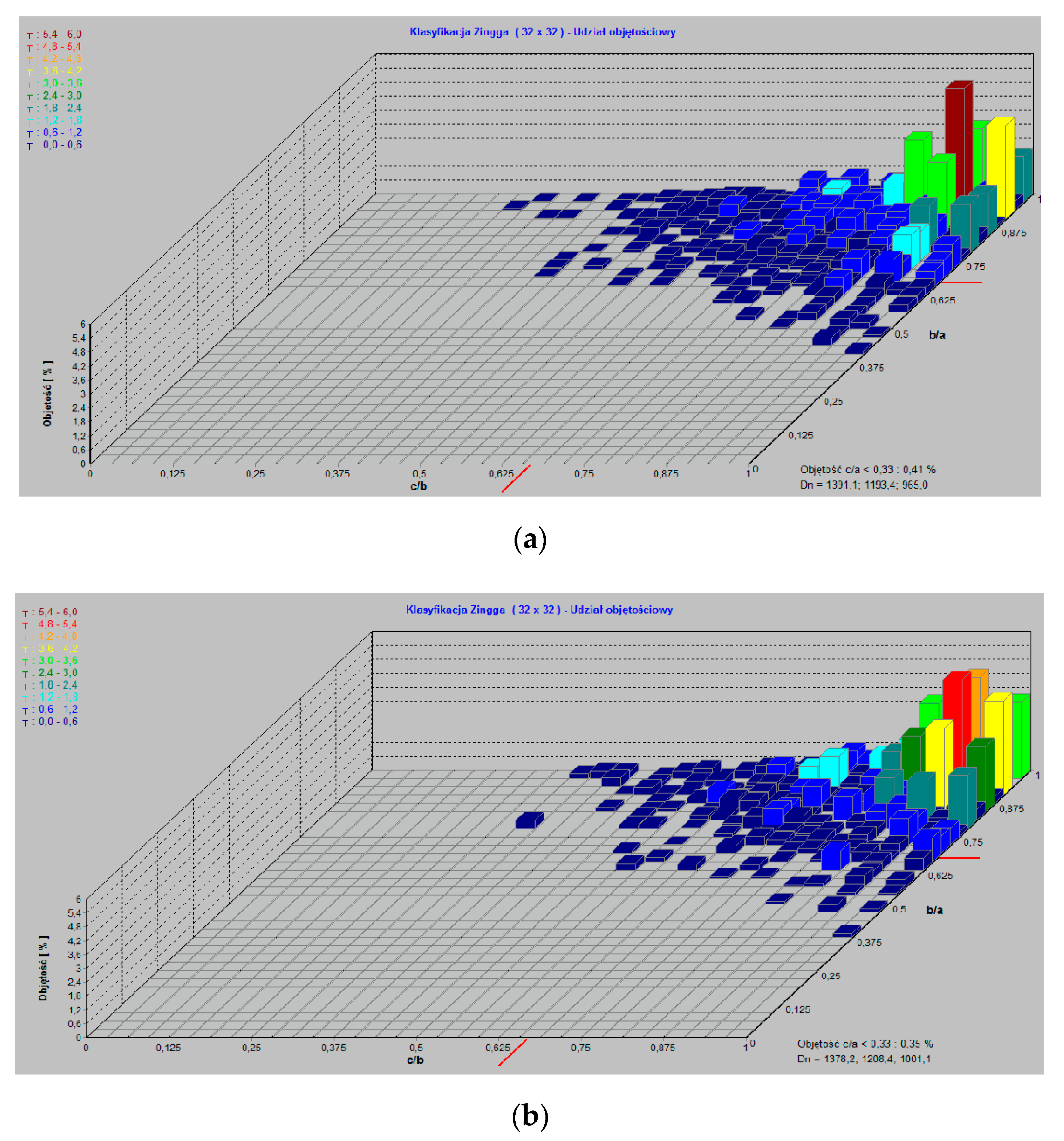

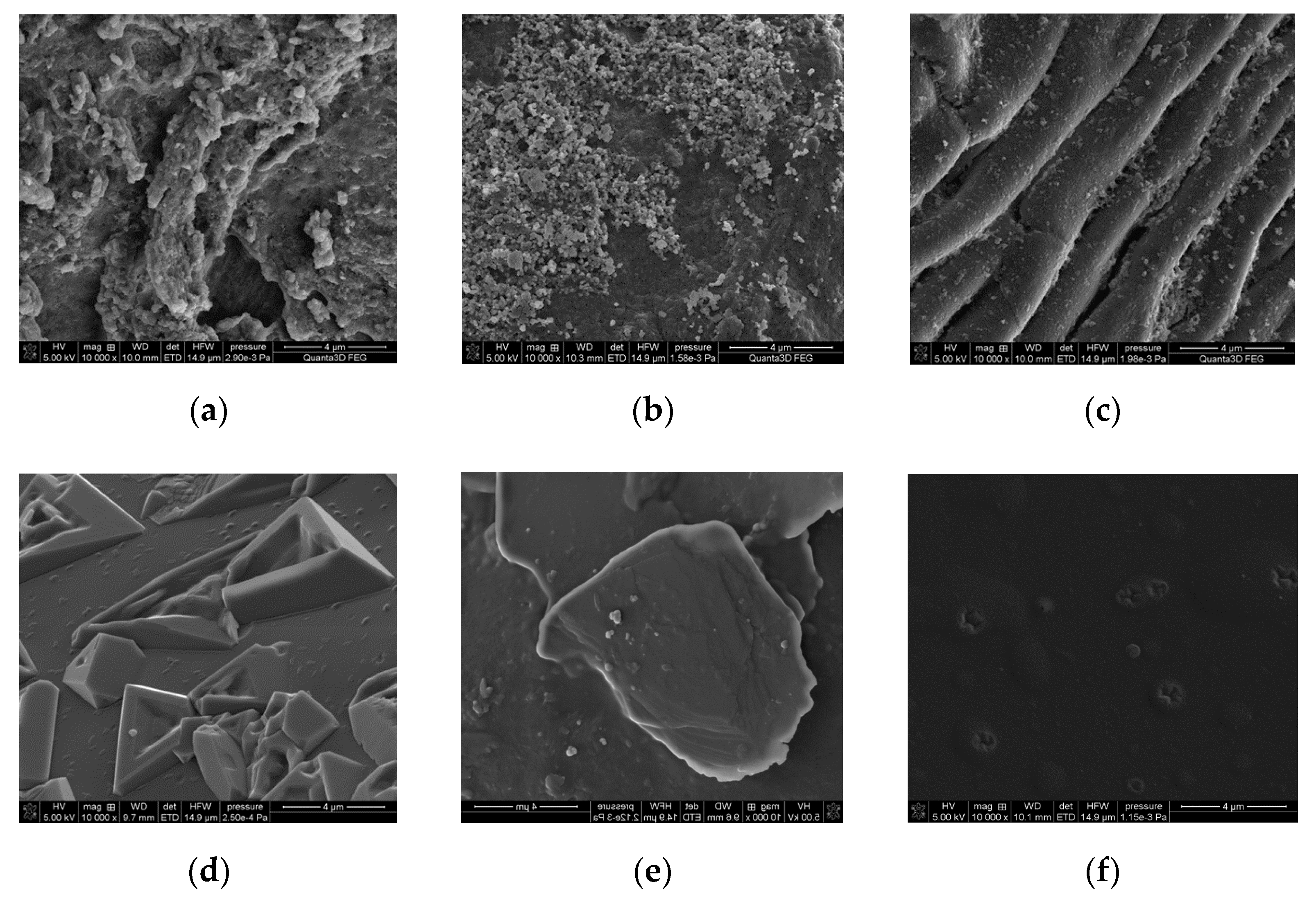

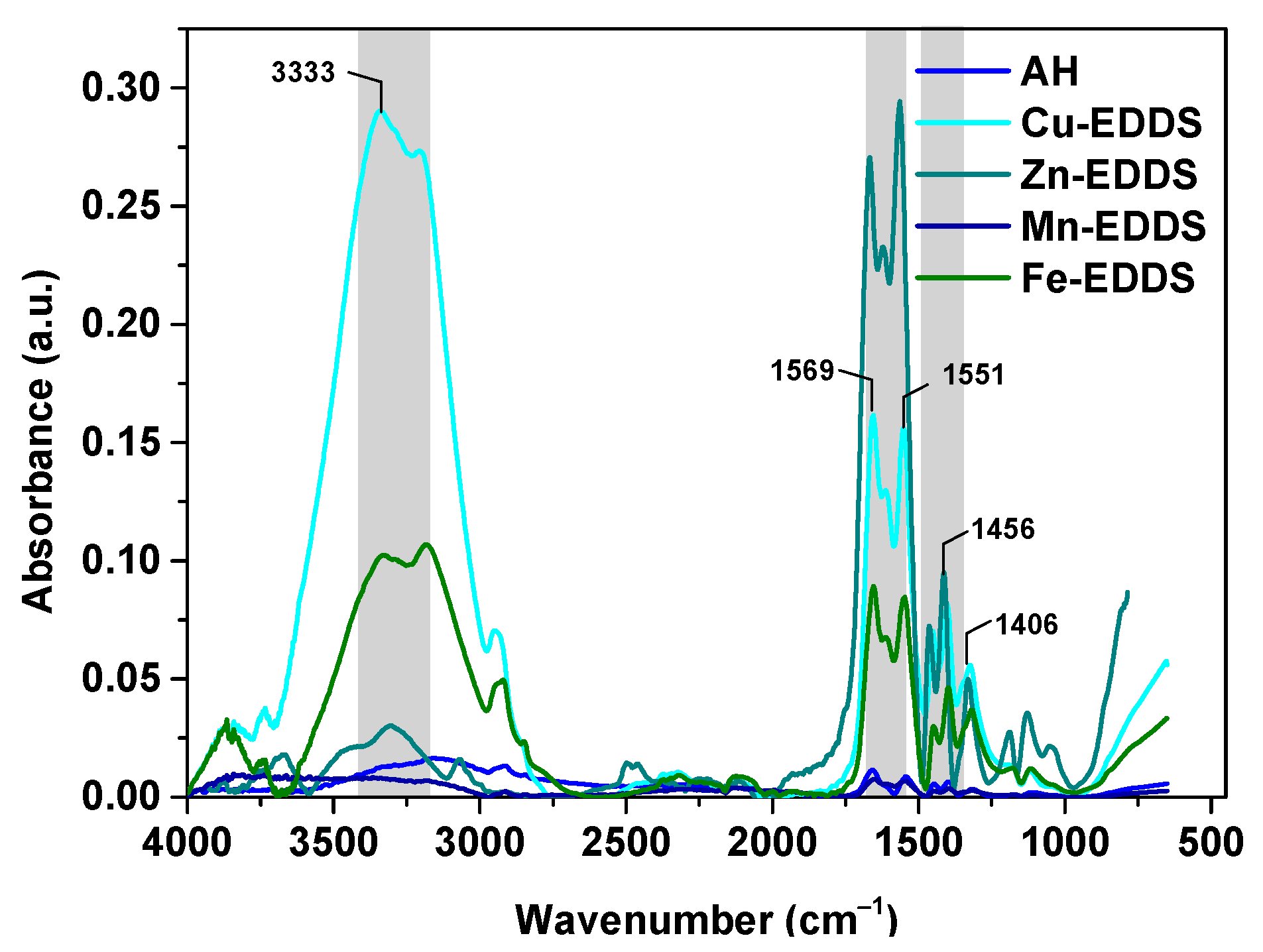
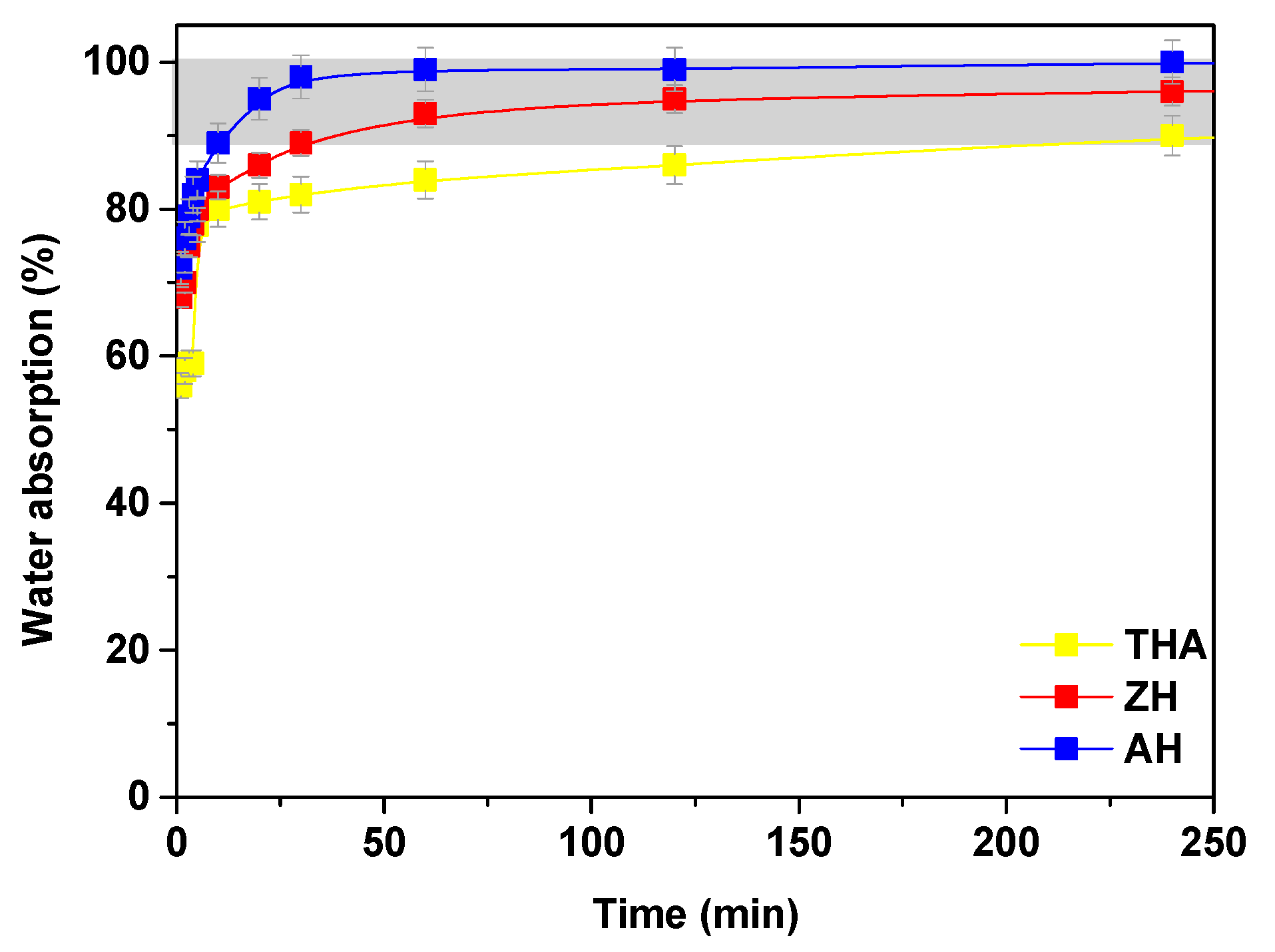

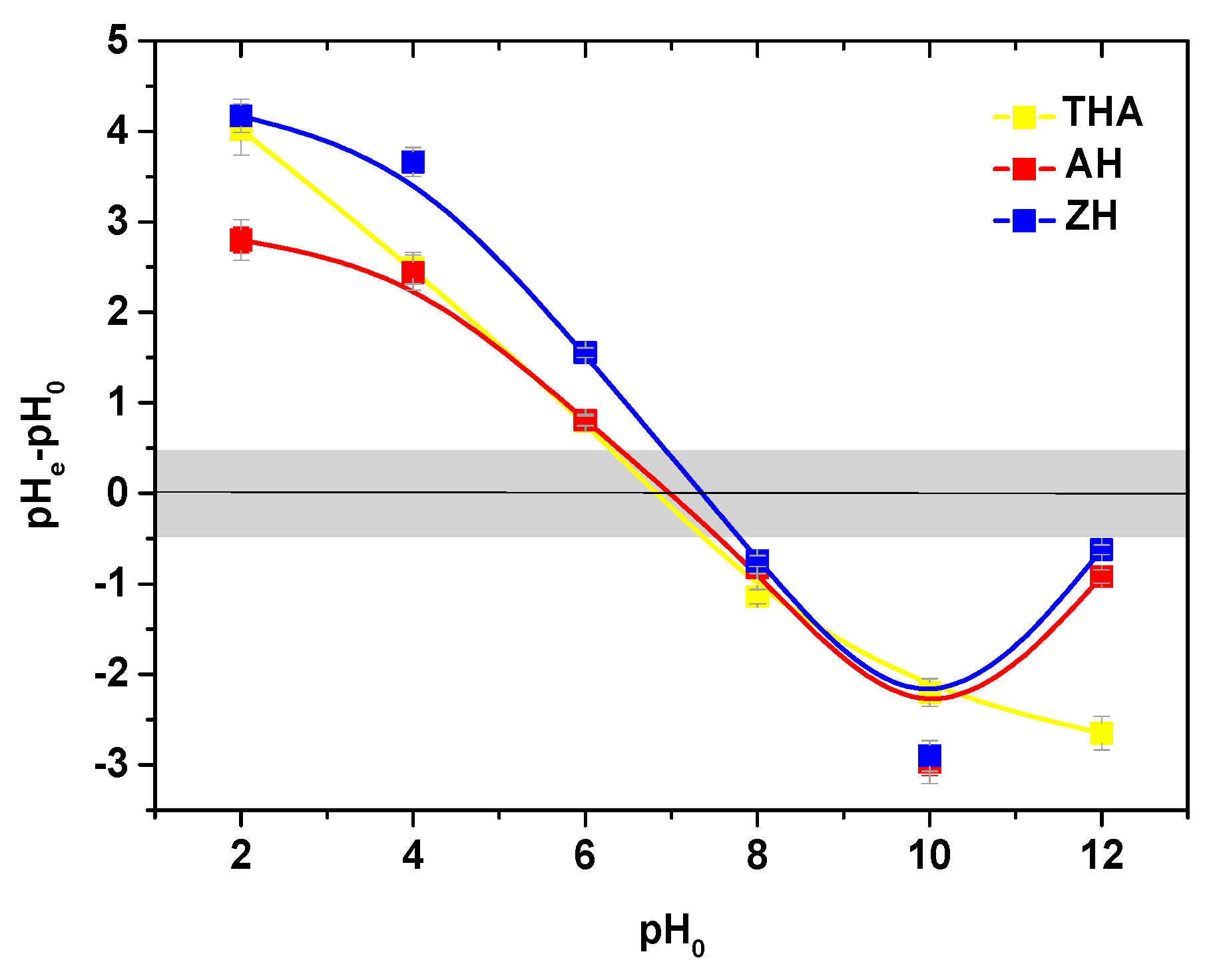
| Superabsorbent | THA | ZH | AH |
|---|---|---|---|
| Matrix | acrylic based | modified starch | acrylic based |
| Cross-linking | polyacrylate | acrylamide–polyacrylate | acrylamide–polyacrylate |
| Appearance | white | white-yellow | white |
| Bead size (mm) | 0.177–0.255 | n.a. | 0.300–1.000 |
| Commercial form | Na+ | K+ | K+ |
| Operating pH range | 6–8 | 5–9 | 5–9 |
| Hydrogel | M(II)/(III) | PFO | PSO | IPD | |||||
|---|---|---|---|---|---|---|---|---|---|
| qe1 mg/g | k1 1/min | R2 | qe2 mg/g | k2 g/mg min | R2 | ki mg/g min | R2 | ||
| THA | Cu(II) | 5.43 | 0.069 | 0.9626 | 15.48 | 0.047 | 0.9999 | 4.73 | 0.9585 |
| Zn(II) | 5.60 | 0.034 | 0.7961 | 16.61 | 0.025 | 0.9999 | 5.21 | 0.9359 | |
| Mn(II) | 4.51 | 0.073 | 0.8284 | 14.54 | 0.081 | 0.9999 | 3.68 | 0.9799 | |
| Fe(III) | 8.61 | 0.054 | 0.9248 | 14.58 | 0.013 | 0.9994 | 3.28 | 0.9512 | |
| ZH | Cu(II) | 3.92 | 0.011 | 0.9077 | 15.55 | 0.019 | 0.9997 | 4.22 | 0.9006 |
| Zn(II) | 5.91 | 0.033 | 0.8694 | 17.15 | 0.022 | 0.9999 | 4.74 | 0.9473 | |
| Mn(II) | 3.26 | 0.035 | 0.9287 | 14.53 | 0.047 | 0.9999 | 4.93 | 0.9521 | |
| Fe(III) | 5.61 | 0.037 | 0.8800 | 12.32 | 0.019 | 0.9998 | 2.78 | 0.8606 | |
| Cu(II) | 4.48 | 0.074 | 0.9385 | 14.74 | 0.069 | 0.9999 | 4.71 | 0.9962 | |
| Zn(II) | 10.51 | 0.020 | 0.7056 | 22.64 | 0.008 | 0.9993 | 4.90 | 0.9868 | |
| AH | Mn(II) | 4.48 | 0.016 | 0.9523 | 15.96 | 0.021 | 0.9989 | 4.62 | 0.9813 |
| Fe(III) | 7.54 | 0.011 | 0.7214 | 16.39 | 0.009 | 0.9935 | 4.44 | 0.9893 | |
| Hydrogel | qmax mg/g | References |
|---|---|---|
| hydrogel based on chitosan, itaconic and methacrylic acid | 105.5 | [18] |
| pH sensitive hydrogel | 110 | [24] |
| chelating polymeric hydrogel | 83.2 | [25] |
| commercial hydrogel beads | 132.5 | [26] |
| xylene-rich hemicellulose-based hydrogel | 274.0 | [27] |
| acryloamide polyacrylate (ZH) | 16.97 * | this study |
| Hydrogel | Langmuir Model | Freundlich Model | |||||
|---|---|---|---|---|---|---|---|
| q0 | RL | KL | R2 | KF | 1/n | R2 | |
| 293 K | |||||||
| THA | 48.69 | 0.878 | 0.009 | 0.9986 | 1.91 | 0.48 | 0.9363 |
| ZH | 54.11 | 0.846 | 0.012 | 0.9974 | 2.23 | 0.48 | 0.9191 |
| AH | 56.52 | 0.798 | 0.016 | 0.9989 | 5.20 | 0.35 | 0.9499 |
| 313 K | |||||||
| THA | 52.12 | 0.850 | 0.011 | 0.9988 | 2.86 | 0.43 | 0.9226 |
| ZH | 58.41 | 0.851 | 0.011 | 0.9984 | 2.41 | 0.47 | 0.9245 |
| AH | 37.35 | 0.972 | 0.018 | 0.9991 | 5.59 | 0.35 | 0.9434 |
| 333 K | |||||||
| THA | 55.78 | 0.818 | 0.014 | 0.9983 | 5.79 | 0.34 | 0.9979 |
| ZH | 63.58 | 0.871 | 0.010 | 0.9973 | 4.21 | 0.40 | 0.9906 |
| AH | 39.33 | 0.973 | 0.018 | 0.9993 | 5.71 | 0.36 | 0.9397 |
| Hydrogel | T K | ΔG° kJ/mol | ΔH° kJ/mol | ΔS° J/mol K |
|---|---|---|---|---|
| THA | 293 313 333 | −14.71 | −3.08 | −20.3 |
| ZH | 293 313 333 | −12.95 | −1.77 | −21.7 |
| AH | 293 313 333 | −12.14 | −2.93 | −28.0 |
| Desorbing Agent | Desorption Efficiency % |
|---|---|
| 0.1 M HNO3 | 99.0 |
| 0.1 M HCl | 97.8 |
| 1 M HNO3 | 100.0 |
| 1 M HCl | 100.0 |
| distilled water | 45.0 |
| Shape | THA [%] | ZH [%] | AH [%] |
|---|---|---|---|
| Sphere | 75.38 | 82.93 | 75.52 |
| Disc | 18.98 | 12.73 | 19.21 |
| Rod | 5.40 | 4.15 | 4.69 |
| Blade | 0.24 | 0.19 | 0.58 |
Publisher’s Note: MDPI stays neutral with regard to jurisdictional claims in published maps and institutional affiliations. |
© 2021 by the authors. Licensee MDPI, Basel, Switzerland. This article is an open access article distributed under the terms and conditions of the Creative Commons Attribution (CC BY) license (https://creativecommons.org/licenses/by/4.0/).
Share and Cite
Kołodyńska, D.; Drozd, A.; Ju, Y. Superabsorbents and Their Application for Heavy Metal Ion Removal in the Presence of EDDS. Polymers 2021, 13, 3688. https://doi.org/10.3390/polym13213688
Kołodyńska D, Drozd A, Ju Y. Superabsorbents and Their Application for Heavy Metal Ion Removal in the Presence of EDDS. Polymers. 2021; 13(21):3688. https://doi.org/10.3390/polym13213688
Chicago/Turabian StyleKołodyńska, Dorota, Alicja Drozd, and Yongming Ju. 2021. "Superabsorbents and Their Application for Heavy Metal Ion Removal in the Presence of EDDS" Polymers 13, no. 21: 3688. https://doi.org/10.3390/polym13213688







